We already brought you a list of the 50 Healthiest Foods of All Time. Now, we’ve gathered another 50, chosen by TIME editors and registered dietitian Alicia Romano from Tufts Medical Center. While most of us know the basics of how to eat well, sometimes putting together a menu for the week can be daunting. So we are providing you with lots of options. All these foods are highly nutritious and they’re also easy to find at the local grocery store. Bring this list on your next trip to the supermarket, select something new, and prepare it as simply as you like (we offer easy recipes and cooking tips too). Bon appétit!
Harissa

Why it’s good for you: This spicy chili paste or powder is having a moment, and for good reason. Recipes for harissa can differ, but in general they usually contain a mixture of healthy ingredients like chili peppers, garlic, olive oil and spices. Chili peppers contain a compound called capsaicin, which is thought to have pain-relief and cancer-protective effects.
How to eat it: It’s super versatile and can be dotted onto fried eggs, mixed into soups or stews, mashed into potatoes—the list goes on. Here’s one recipe: Whole Roasted Carrots with Black Lentils and Green Harissa
Nutrition per 2 tsp: Calories: 15, Fat: 1 g, Cholesterol: 0 mg, Sodium: 36 mg, Carbohydrates: 2 g, Dietary fiber: 1 g, Sugars: 0 g, Protein: 1 g.
Goat Cheese
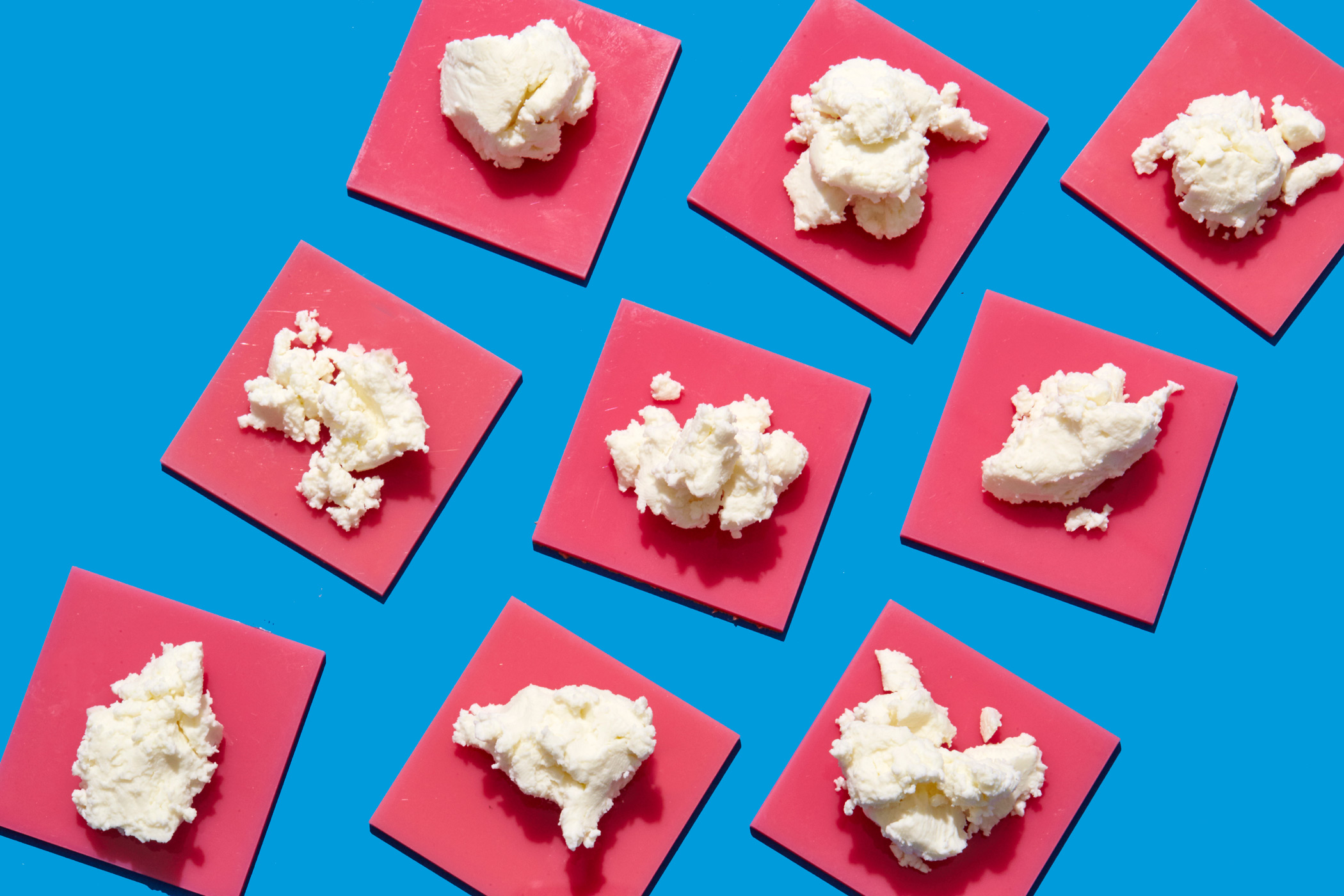
Why it’s good for you: Goat cheese can feel indulgent but it actually has less fat per serving than most other cheeses. It also contains protein, calcium and 3% of your daily dose of iron in just an ounce. (Some research has suggested that compared to cow milk, goat milk increases iron absorption and benefits your bones.) Still not convinced? Don’t forget that eating for pleasure is good for your health as well.
How to eat it: However you like it! This recipe combines other healthy superstar ingredients, too: Quinoa-Stuffed Kale Rolls with Goat Cheese
Nutrition per 1 ounce: Calories: 103, Fat: 8.5 g, Cholesterol: 22 mg, Sodium: 118 mg, Carbohydrates: 0.03 g, Dietary fiber: 0 g, Sugars: 0.03 g, Protein: 6 g.
Popcorn

Why it’s good for you: Popcorn is a high-fiber food that should top your list of go-to snacks. We’re not talking about movie theater popcorn, of course. Air-popped popcorn without lots of melted butter and salty seasonings is best. One study even suggested popcorn is more satisfying than potato chips possibly due its irregular shape and high volume.
How to eat it: Try making your popcorn on the stove, it’s simple and fast! Instead of butter, sprinkle some parmesan and a little salt.
Nutrition per 1 cup, air-popped: Calories: 31, Fat: 0.4 g, Cholesterol: 0 mg, Sodium: 1 mg, Carbohydrates: 6 g, Dietary fiber: 1 g, Sugars: 0.07 g, Protein: 1 g.
Coconut

Why it’s good for you: Coconut is a healthy choice for people with a taste for richness. It has health benefits too. It contains a good helping potassium, which can help curb stroke risk, and some research has also shown that adding a little coconut water to rice and letting it cool makes it less caloric. Coconut water, however, is not a replacement for the real fruit, with some research suggesting the water doesn’t always meet its nutritional claims.
How to eat it: Keep unsweetened shredded coconut in your fridge and sprinkle it on a raw kale or collard green salad. With a tangy vinaigrette on top it’s just delicious, and the small amount of fat it adds makes the salad’s nutrients more bioavailable.
Nutrition per 1 cup, shredded: Calories: 283, Fat: 27 g, Cholesterol: 0 mg, Sodium: 16 mg, Carbohydrates: 12 g, Dietary fiber: 7 g, Sugars: 5 g, Protein: 2.7 g.
Grass-Fed Beef

Why it’s good for you: Grass-fed beef is lower in saturated fat than conventional beef and higher in “good fats” such as omega-3s, monounsaturated fatty acids, and conjugated linoleic acid. It’s also a great source protein and iron, which is important for growth and development.
How to eat it: Whatever cut you like, prepared as you normally would. We also like this: Grass-Fed Beef Tenderloin Steaks with Sautéed Mushrooms
Nutrition per 3 ounces: Calories: 99, Fat: 2.3 g, Cholesterol: 47 mg, Sodium: 47 mg, Carbohydrates: 0 g, Dietary fiber: 0 g, Sugars: 0 g, Protein: 20 g.
Ghee

Why it’s good for you: Ghee is a clarified butter that is made by melting butter and skimming off some of the fat. It can be easier for some people to digest and is a staple of Indian cuisine. It also has a slightly nutty flavor. It’s high in vitamins and can be used as an alternative to cooking oils or butters.
How to eat it: Use ghee as a cooking tool for a new flavor and a commendable nutritional profile.
Nutrition per 1 tsp: Calories: 45, Fat: 5 g, Cholesterol: 15 mg, Sodium: 0 mg, Carbohydrates: 0 g, Dietary fiber: 0 g, Sugars: 0 g, Protein: 0 g.
Canned Salmon
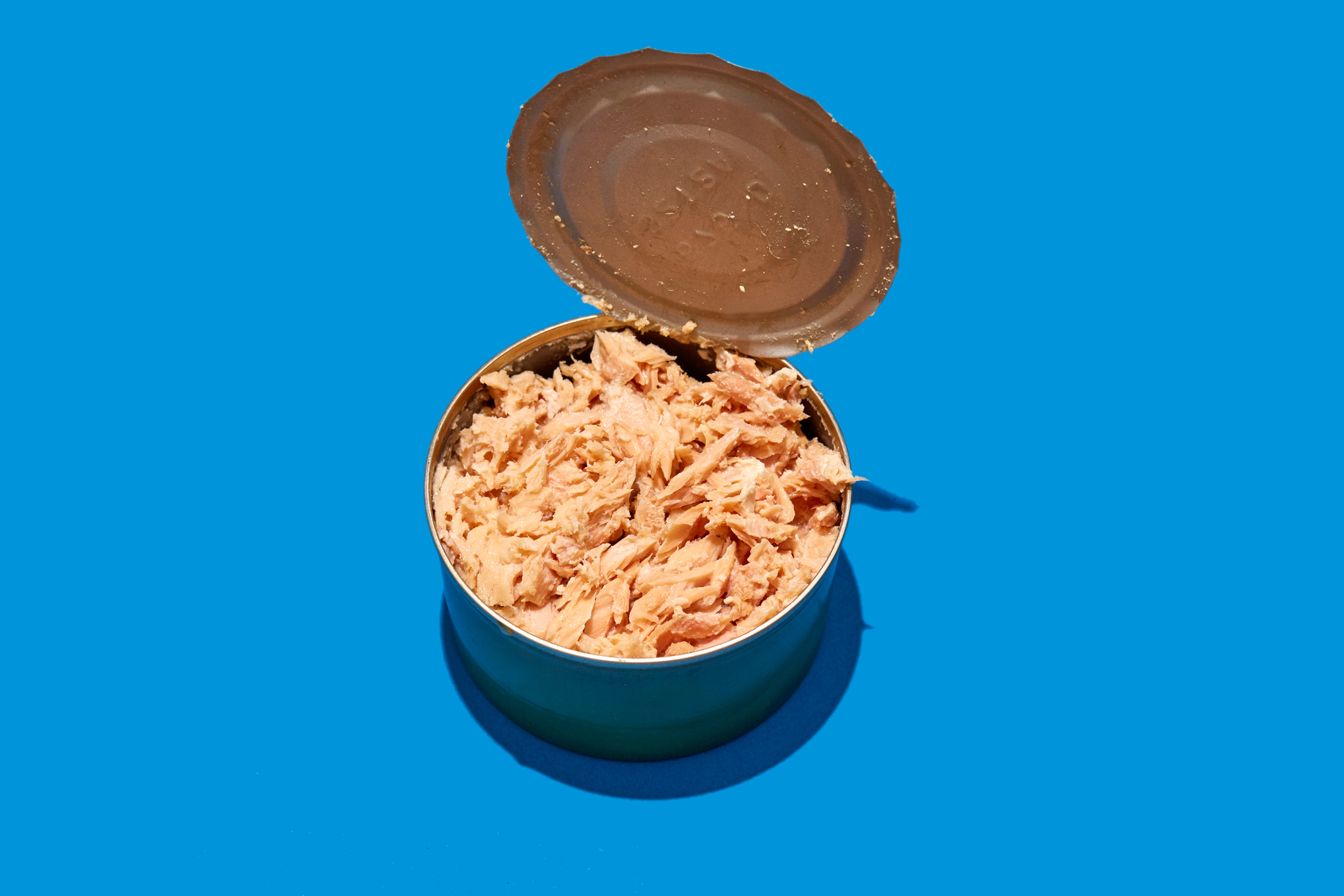
Why it’s good for you: Less expensive than fresh salmon, the canned version is one of the richest food sources of vitamin D which is good for bone health and calcium absorption. Its omega-3 fatty acids are another added bonus.
How to eat it: Canned salmon contains the small salmon bones, and you’ll definitely want to eat them—they’re a great source of calcium that our bodies can more easily absorb than plant sources of calcium. Frying salmon burgers with bread crumbs, eggs, spices, lemon zest and canned salmon, couldn’t be easier.
Nutrition per 1 can: Calories: 530, Fat: 20 g, Cholesterol: 226 mg, Sodium: 1656 mg, Carbohydrates: 0 g, Dietary fiber: 0 g, Sugars: 0 g, Protein: 60 g.
Spirulina

Why it’s good for you: Spirulina is a blue-green algae that is high in lots of vitamins, nutrients and antioxidants that protect cells. It’s also a good vegetarian source of protein. It can come in pill, powder or flake form, and it’s worth doing your research for a trusted variety.
How to eat it: Add a teaspoon to your morning smoothie or oatmeal.
Nutrition per 1 tbsp: Calories: 20, Fat: 0.5 g, Cholesterol: 0 mg, Sodium: 73 mg, Carbohydrates: 1.7 g, Dietary fiber: 0.3 g, Sugars: 0.2 g, Protein: 4 g.
Lemon

Why they’re good for you: This citrus fruit may be too acidic to eat as you would a milder orange, but it’s similarly high in vitamin C, which helps protect cells from damage and is needed by the body to make collagen, which is important for wound healing. Not to mention adding a little lemon zest to any meal adds a flavor kick.
How to eat it: The easiest way to get vitamin C into your diet without taking pills is to drink lemon water. It’s tasty, satisfying and some people swear that if you drink it in the morning, it kickstarts digestion for the day. More evidence is needed, but it can’t hurt—and it tastes great.
Nutrition per 1 fruit: Calories: 17, Fat: 0.2 g, Cholesterol: 0 mg, Sodium: 1 mg, Carbohydrates: 5.4 g, Dietary fiber: 2 g, Sugars: 1.5 g, Protein: 0.6 g.
Tofu
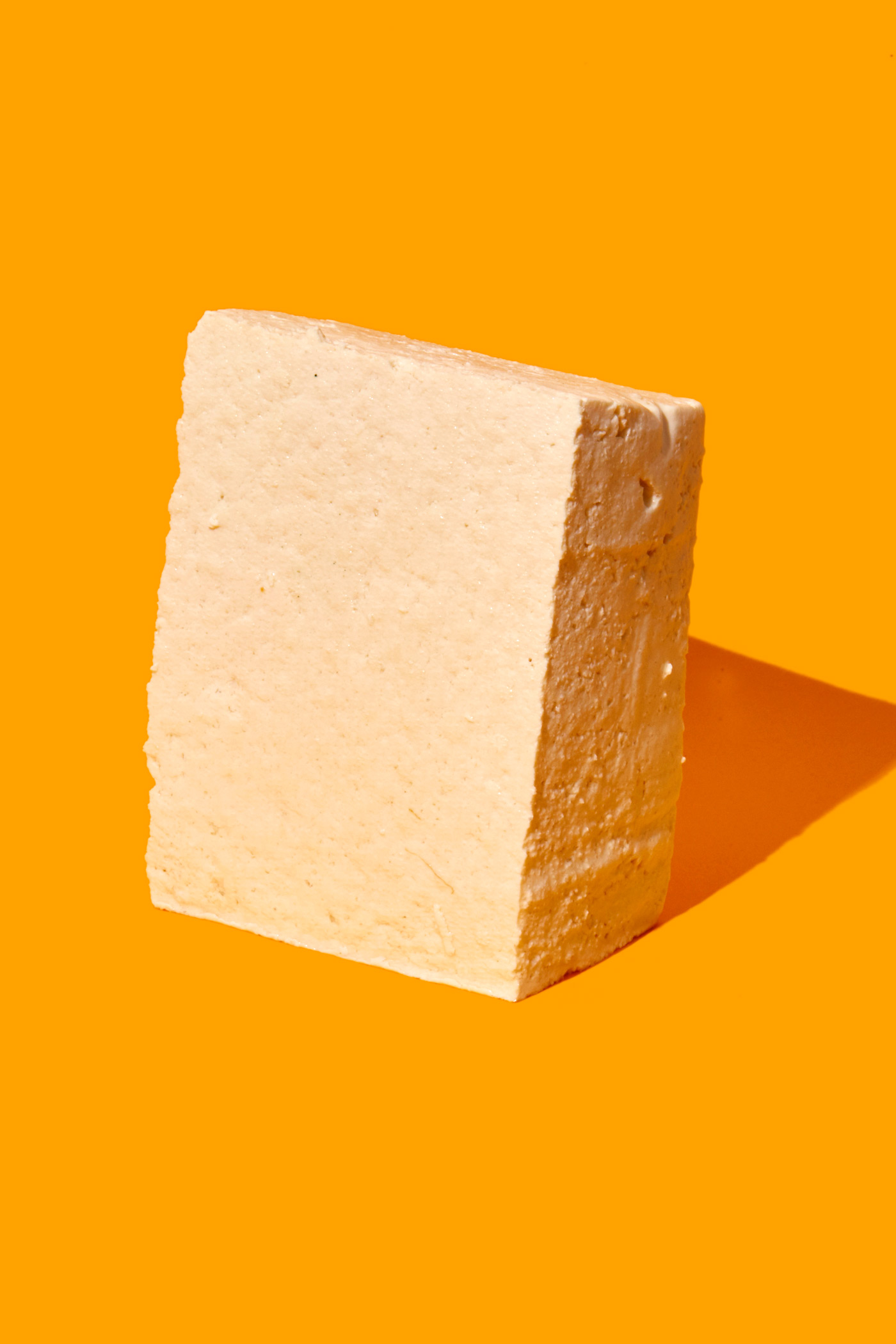
Why it’s good for you: Tofu is a great plant-based protein source, and it’s high in calcium, protein and iron. Tofu also contains isoflavones, which have benefits related to heart health and a decreased risk of breast and prostate cancer.
How to eat it: Try the soft kind of tofu that has the consistency of jelly. It’s great raw in salads instead of hard-boiled eggs, and you can slice it and dredge in a little egg wash and pan fry for a great appetizer. Top with soy sauce mixed with sesame oil, green onion and black pepper and if you like it spicy, a little sriracha.
Nutrition per 1/2 cup: Calories: 98, Fat: 5.3 g, Cholesterol: 0 mg, Sodium: 15 mg, Carbohydrates: 3.6 g, Dietary fiber: 1 g, Sugars: 1 g, Protein: 11.4 g.
Dandelion Greens

Why they’re good for you: Bitter greens—like dandelion—are rich in vitamin C as well as B vitamins, calcium, iron and potassium. That’s an ideal mix for healthy bones and muscles.
How to eat it: In salads, stewed in stock or like this: Dandelion-Stuffed Pork Loin
Nutrition per 1 cup, chopped: Calories: 25, Fat: 0.4 g, Cholesterol: 0 mg, Sodium: 42 mg, Carbohydrates: 5 g, Dietary fiber: 2 g, Sugars: 0.4 g, Protein: 1.5 g.
Purple Potatoes
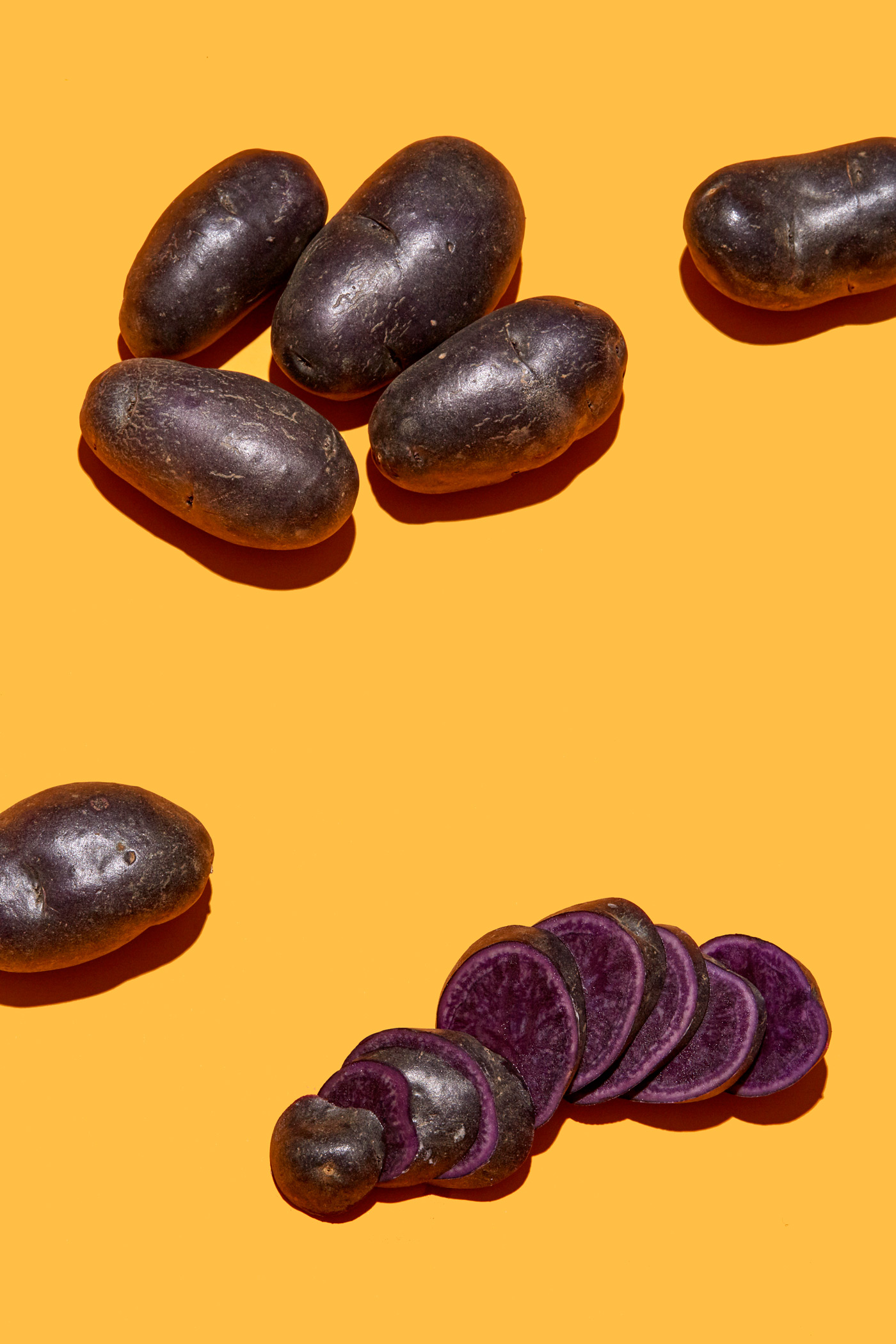
Why they’re good for you: Like all spud varieties, purple potatoes are rich in potassium—which is needed for blood pressure management. What’s special about purple potatoes are their color, which comes from anthocyanin, a potent antioxidant that poses numerous health benefits like a lower risk for cardiovascular disease.
How to eat it: However you’d eat a regular potato. Or like this: Chilean Beef and Purple Potato Salad.
Nutrition per medium-sized potato: Calories: 93, Fat: 0 g, Cholesterol: 0 mg, Sodium: 7 mg, Carbohydrates: 20 g, Dietary fiber: 1 g, Sugars: 0 g, Protein: 3 g.
Nutritional Yeast
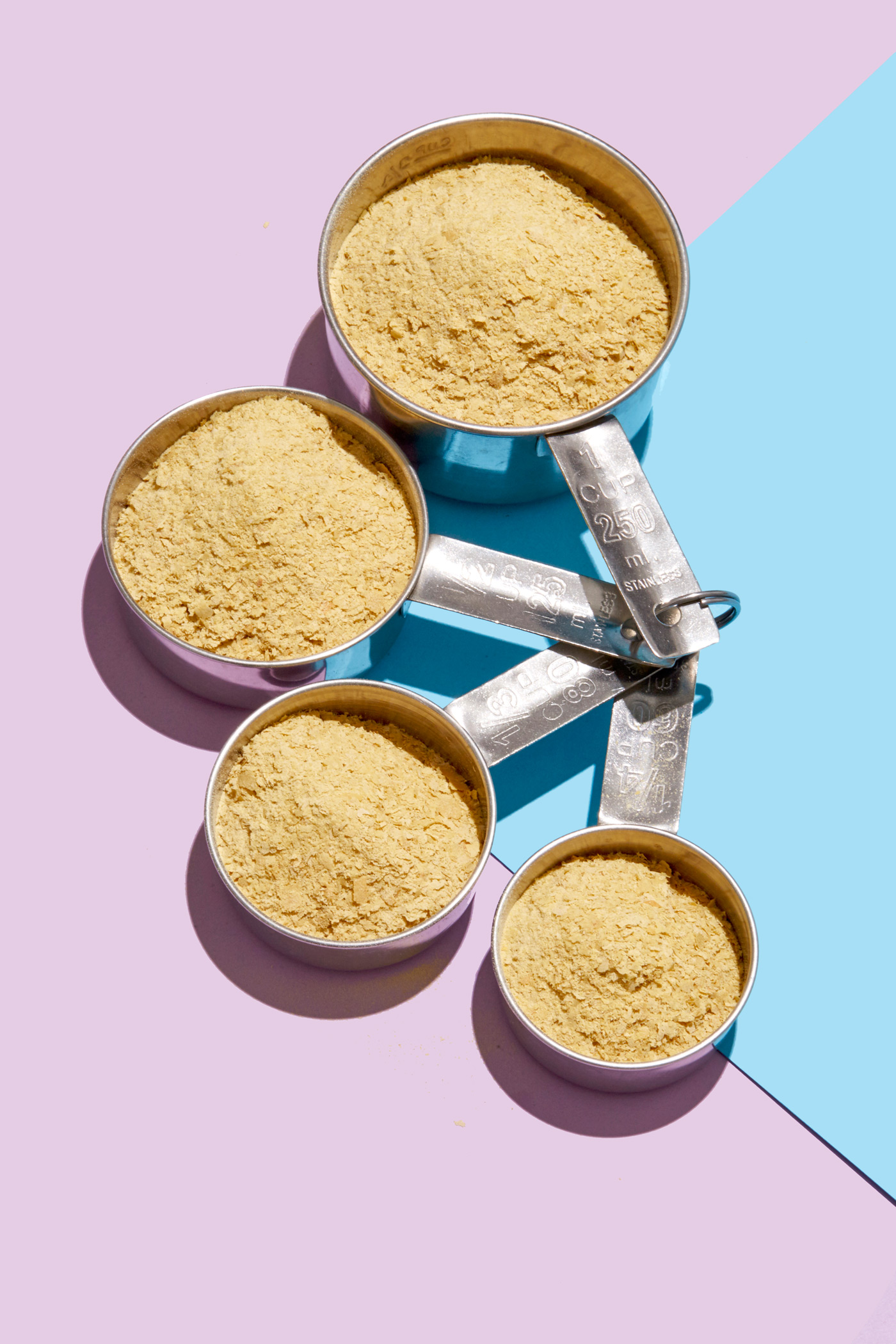
Why it’s good for you: Come for the crazy good flavor (nutty, savory and somehow cheesy) and stay for the nutritional punch. Nutritional yeast is a complete protein with all nine essential amino acids as well as zinc, selenium, B vitamins, protein and fiber. (Nutritional yeast is an inactive yeast that’s grown in a culture to make a seasoning rich in nutrients.)
How to eat it: Some people call this flaky nutritional powerhouse “vegan parmesan” but think of it more as a healthy B-vitamin-and-protein-laced umami bomb. It’s incredible on popcorn with a little olive oil and some spices. It’s also great as a thickener in pesto, or in any vegetable puree, including cauliflower, mashed potatoes, or “creamed” kale or spinach.
Nutrition per¼ cup: Calories: 60, Fat: 0.5 g, Cholesterol: 0 mg, Sodium: 25 mg, Carbohydrates: 5 g, Dietary fiber: 3 g, Sugars: 0 g, Protein: 8 g.
Oysters

Why they’re good for you: Oysters are a great source of protein, omega-3 fatty acids, iron, calcium, zinc, and B12. Vitamin B12 is important since it keeps the body’s nerve and blood cells in good health. Sadly, the data on their effectiveness as an aphrodisiac is less robust.
How to eat it: Learning how to shuck oysters makes for a great party trick instead of simply offering guests the usual appetizer plate.
Nutrition per 6 medium: Calories: 43, Fat: 1.4 g, Cholesterol: 34 mg, Sodium: 71 mg, Carbohydrates: 2.3 g, Dietary fiber: 0 g, Sugars: 0.5 g, Protein: 5 g.
Mango

Why it’s good for you: This is a very versatile stone fruit, with colors that range from green with a reddish blush to bright yellow. Mangos are also chock full of vitamins and antioxidants, especially vision protective vitamin A: One whole mango provides 45% of your daily value.
How to eat it: Eat it whole, in a smoothie or in any of Cooking Light’s 38 best mango recipes.
Nutrition per 1 fruit: Calories: 202, Fat: 1.3 g, Cholesterol: 0 mg, Sodium: 3 mg, Carbohydrates: 50.3 g, Dietary fiber: 5.4g, Sugars: 46 g, Protein: 2.8 g.
Strawberries
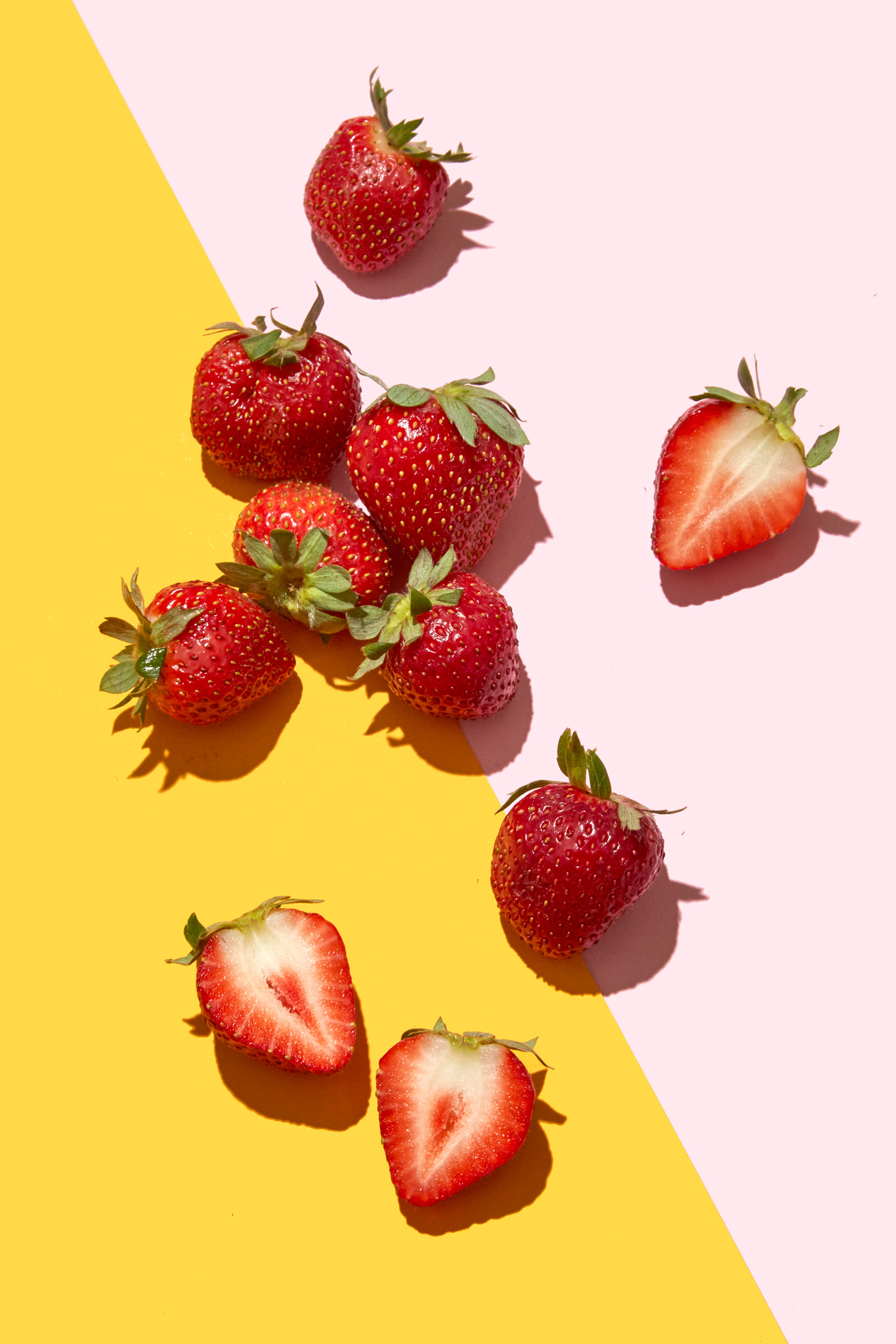
Why they’re good for you: Strawberries are a good source of vitamin C and other compounds involved in metabolism and bone health. They’re also high in a subtype of flavonoids called anthocyanins, which are thought to be heart-healthy. A 2013 study of 93,600 women found those who ate more than three or more servings of 1/2 cup of strawberries or blueberries each week had a lower risk for heart attack.
How to eat it: You don’t need our help with this one but here are 20 irresistible strawberry recipes anyway.
Nutrition per 1 cup: Calories: 46, Fat: 0.43 g, Cholesterol: 0 mg, Sodium: 1 mg, Carbohydrates: 11 g, Dietary fiber: 3 g, Sugars: 8.1 g, Protein: 1 g.
Blackberries

Why they’re good for you: Blackberries in particular are high in fiber, which can increase how full and satisfied you feel after eating, as well as vitamins C, K and manganese. Research has also linked berry consumption to a wealth of benefits for the body and mind, like lower rates of cognitive decline. The compounds that make their colors so vibrant can also lower inflammation and support the immune system.
How to eat it: Bring two cups of steel-cut oats, a pinch of salt, and eight cups of water to a boil. Then turn off the heat, leave it overnight, and top it with blackberries.
Nutrition per 1 cup: Calories: 62, Fat: 0.7 g, Cholesterol: 0 mg, Sodium: 1 mg, Carbohydrates: 14 g, Dietary fiber: 8 g, Sugars: 7 g, Protein: 2 g.
Artichokes

Why they’re good for you: Artichokes have a meaty texture, and the vegetables are a nutritional powerhouse, rich in folate, dietary fiber, vitamin C, vitamin K and abundant in antioxidants such as quercetin and anthocyanins. When selecting a fresh artichoke to take home, pick one that’s heavy and firm (weight is less important with baby artichokes, of course).
How to eat it: Roasted artichokes take some preparation—you have to remove the tough outer leaves, peel the stem, chop off the top and then soak them in lemon water so they don’t brown—but the task can be meditative and the result is delicious. Serve with a simple dipping sauce of greek yogurt (or mayo, if you want a treat) mixed with garlic and curry.
Nutrition per 1 medium artichoke: Calories: 60, Fat: 0.2 g, Cholesterol: 0 mg, Sodium: 120 mg, Carbohydrates: 13.5 g, Dietary fiber: 7 g, Sugars: 1.3 g, Protein: 4.2 g.
Sauerkraut
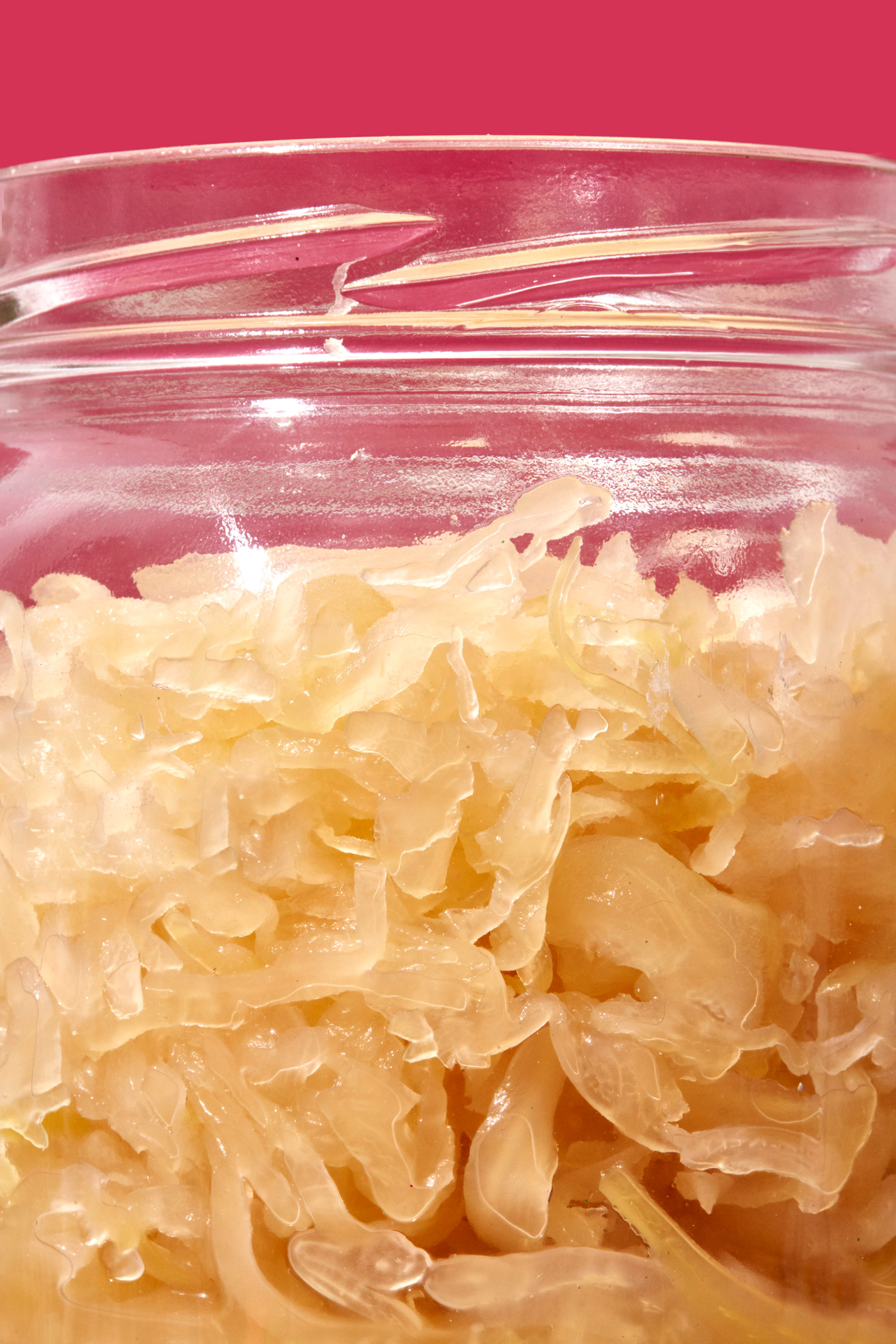
Why it’s good for you: Sauerkraut is fermented cabbage that contains fiber and multiple vitamins that make it a good addition to your dinner plate. Sauerkraut is a good source of iron, manganese, copper, sodium, magnesium, and calcium. Not to mention it contributes a moderate amount of protein to your diet. Like other fermented foods, sauerkraut contains probiotics that benefit the gut and digestion.
How to eat it: You can do the fermenting yourself with this recipe for Red Sauerkraut or buy it pre-made and eat it on its own, with eggs, or mixed into salads or slaws.
Nutrition per 1 cup: Calories: 27, Fat: 0.2 g, Cholesterol: 0 mg, Sodium: 939 mg, Carbohydrates: 6.1 g, Dietary fiber: 4 g, Sugars: 3 g, Protein: 1.3 g.
Spaghetti Squash

Why it’s good for you: Spaghetti squash has one of the highest water contents of all the winter squash. It’s low in calories and can be used to substitute pasta in many recipes. It also yields a good dose of vitamin A, calcium, vitamin C and fiber.
How to eat it: Substitute it for pasta in your favorite dish. It won’t look exactly the same, but you’ll get a delicious vegetable overload. You can also strain them and form them into patties that you bake in the oven.
Nutrition per 1 cup: Calories: 42, Fat: 0.4 g, Cholesterol: 0 mg, Sodium: 28 mg, Carbohydrates: 10 g, Dietary fiber: 2 g, Sugars: 4 g, Protein: 1 g.
Apples

Why they’re good for you: There’s a reason “an apple a day” is a thing. Apples are rich in a type of fiber that can lower cholesterol levels, making them a heart healthy snack. One study found eating apples led people to eat 15% fewer calories at their next meal. Another perk? They’re helpful for regulating digestion.
How to eat it: Fry up some kale and then saute it with garlic and diced apples.
Nutrition per 1 medium apple: Calories: 95, Fat: 0.3 g, Cholesterol: 0 mg, Sodium: 2 mg, Carbohydrates: 25 g, Dietary fiber: 4 g, Sugars: 19 g, Protein: 0.5 g.
Wild Caught Cod

Why it’s good for you: Wild caught cod is a versatile and sustainable fish that is available throughout the year. Though the fish is lower in fat, a high percentage of its fat comes in the form of omega-3 fatty acids, which are associated with a decreased risk of cardiovascular disease.
How to eat it: Mix up a miso-based marinade and roast it in the oven.
Nutrition per 3 ounces: Calories: 71, Fat: 0.2 g, Cholesterol: 52 mg, Sodium: 114 mg, Carbohydrates: 0 g, Protein: 17.4 g.
Rhubarb

Why it’s good for you: Few leafy foods look as lovely as rhubarb with its deep red stalks and bright green leaves (just remember not to eat the latter, as they’re poisonous). It’s high in vitamins and folate, as well.
How to eat it: Forget jam or pie—try pickling your rhubarb for a savory kick.
Nutrition per 1 stalk: Calories: 11, Fat: 0.1 g, Cholesterol: 0 mg, Sodium: 2 mg, Carbohydrates: 2.3 g, Dietary fiber: 1 g, Sugars: 0.6 g, Protein: 0.5 g.
Beet Greens

Why they’re good for you: It’s hard to compete with the deep reds of beets, but don’t toss the greens that sprout from them. The leaves of some beets, like golden and Chioggia varieties (which are striped on the inside!) are especially lush and thick, and can tossed into salads. They’re high in vitamin A and vitamin K, and a cup boasts 44 mg of calcium.
How to eat it: Beet Soup with Potatoes and Beet Greens
Nutrition per 1 cup: Calories: 8, Fat: 0.05 g, Cholesterol: 0 mg, Sodium: 86 mg, Carbohydrates: 1.7 g, Dietary fiber: 1.4 g, Sugars: 0.2 g, Protein: 0.8 g.
Purple Cauliflower

Why it’s good for you: Like purple potatoes, the unexpected shade of this cauliflower comes from the antioxidant anthocyanin. Cauliflower is low in calories and rich in fiber, vitamin C, folate, manganese, vitamin K and B6 (which is involved in metabolism and early brain development). Consider steaming or stir-frying cauliflower to keep nutrient levels high.
How to eat it: Steamed or roasted at 400 °F and then pureed. Add a glug of olive oil, salt and pepper, and at the end, toss in any fresh herbs you may have, such as thyme, rosemary or even mint and basil. Consider it a healthier and more elevated mashed potato.
Nutrition per 1 cup, chopped: Calories: 27, Fat: 0.3 g, Cholesterol: 0 mg, Sodium: 32 mg, Carbohydrates: 5.3 g, Dietary fiber: 2 g, Sugars: 2 g, Protein: 2.1 g.
Endive
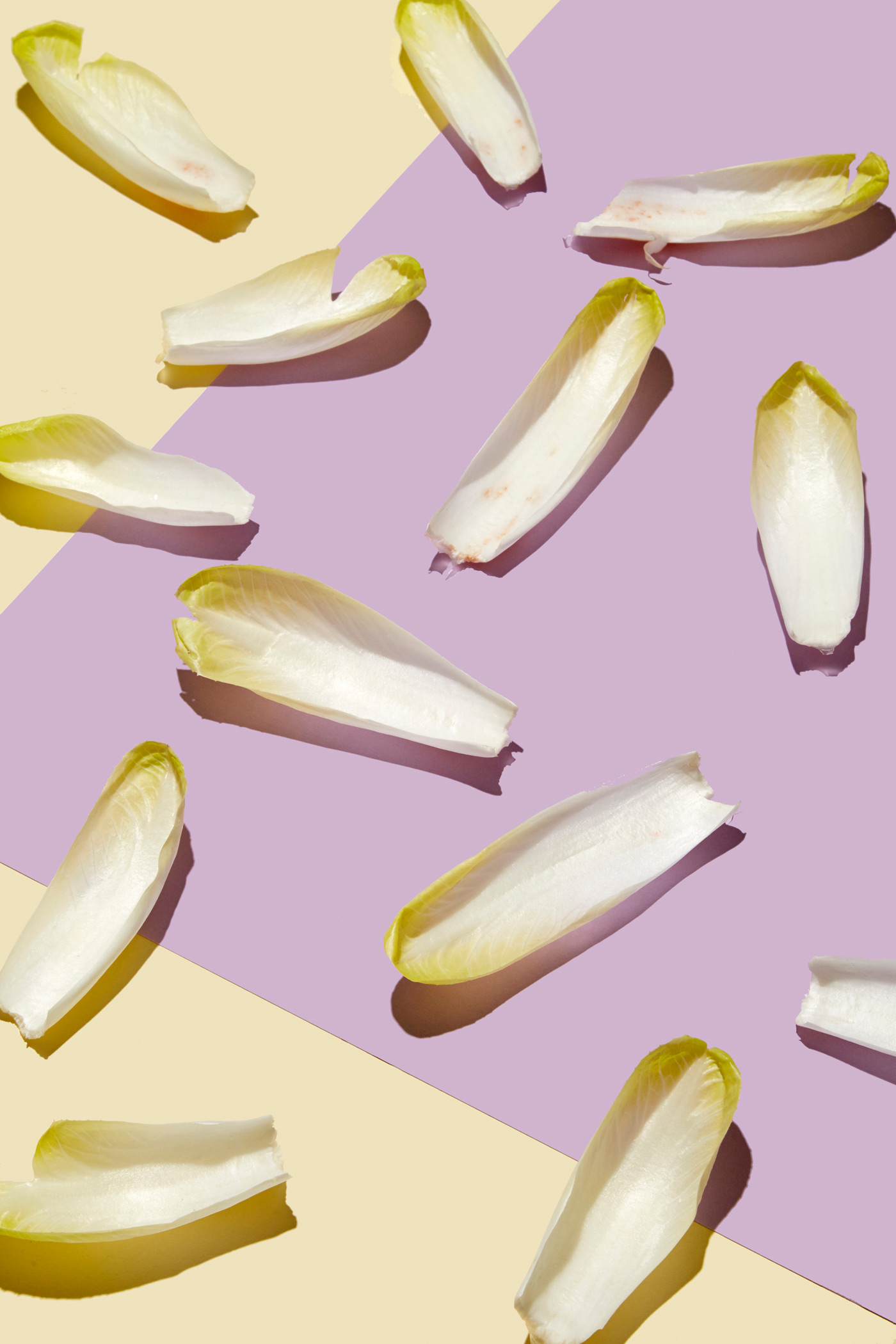
Why it’s good for you: Endive is high in inulin and fiber, which can lower LDL cholesterol levels to benefit the heart. Endive is also a great source of vitamin A and beta-carotene as well as B vitamins, iron and potassium. Often used raw in salads or appetizers, cooked endive can taste sweet and nutty.
How to eat it: Bacon Endive Tomato Bites
Nutrition per 1 cup, chopped: Calories: 8, Fat: 0.1 g, Cholesterol: 0 mg, Sodium: 11 mg, Carbohydrates: 1.7 g, Dietary fiber: 1.6 g, Sugars: 0.1 g, Protein: 0.6 g.
Snap Peas

Why they’re good for you: Small veggies are ideal snacks on the go since they’re high in nutrients and fiber—and they taste great raw. A good snap pea should look moist—when they are dry they taste more starchy. They’re also high in vitamins A, K, and C.
How to eat it: Snap peas are delicious plain or dipped into hummus, but if you want to mix it up a bit, drizzle some red wine vinegar or rice vinegar on top of them, mixed with a little oil, and serve.
Nutrition per 1 cup: Calories: 31, Fat: 0.2 g, Cholesterol: 0 mg, Sodium: 6 mg, Carbohydrates: 7 g, Dietary fiber: 3 g, Sugars: 3.3 g, Protein: 2 g.
Corn

Why it’s good for you: There may be no other vegetable more evocative of summer than corn, though there are certainly reasons to eat it year-round. One ear of corn has approximately the same calories as an apple, with equally high nutrient levels, too. Non-genetically modified corn is also loaded with lutein and zeaxanthin, two phytochemicals that promote healthy vision.
How to eat it: Oaxacan-Style Grilled Corn on the Cob
Nutrition per 1 medium ear: Calories: 99, Fat: 1.5 g, Cholesterol: 0 mg, Sodium: 1 mg, Carbohydrates: 22 g, Dietary fiber: 3 g, Sugars: 5 g, Protein: 4 g.
Pumpkin

Why it’s good for you: Pumpkin is not just for carving. Its seeds are high in potassium and magnesium, and pumpkin flesh is rich in beta carotene, which is good for the immune system. One cup of canned pumpkin contains 7g fiber and 3 grams of protein, which is helpful for regular digestion. Pumpkin also contains 50% of the daily value of vitamin K, which helps prevent blood clotting.
How to eat it: Make a toasted pumpkin seed pesto. Throw them in a food processor with basil, olive oil, parmesan, garlic and lemon juice. Or roast, puree and eat it as a side dish or mixed in with potatoes.
Nutrition per 1 cup mashed: Calories: 49, Fat: 0.2 g, Cholesterol: 0 mg, Sodium: 2 mg, Carbohydrates: 12 g, Dietary fiber: 3 g, Sugars: 5 g, Protein: 1.8 g.
Kimchi

Why it’s good for you: Kimchi is the Korean version of fermented cabbage, and is loaded with vitamin A, B vitamins and vitamin C. Similar to sauerkraut, it contains healthy probiotics that regulate digestion. It adds a kick of flavor to almost any recipe.
How to eat it: You can buy it or make it yourself. It tastes great by the spoonful, or you can try it in a recipe like Kimchi Jjigae (Kimchi-Pork Soup).
Nutrition per 1 cup: Calories: 22, Fat: 0.8 g, Cholesterol: 0 mg, Sodium: 747 mg, Carbohydrates: 4 g, Dietary fiber: 2.4 g, Sugars: 1.6 g, Protein: 1.7 g.
Olives
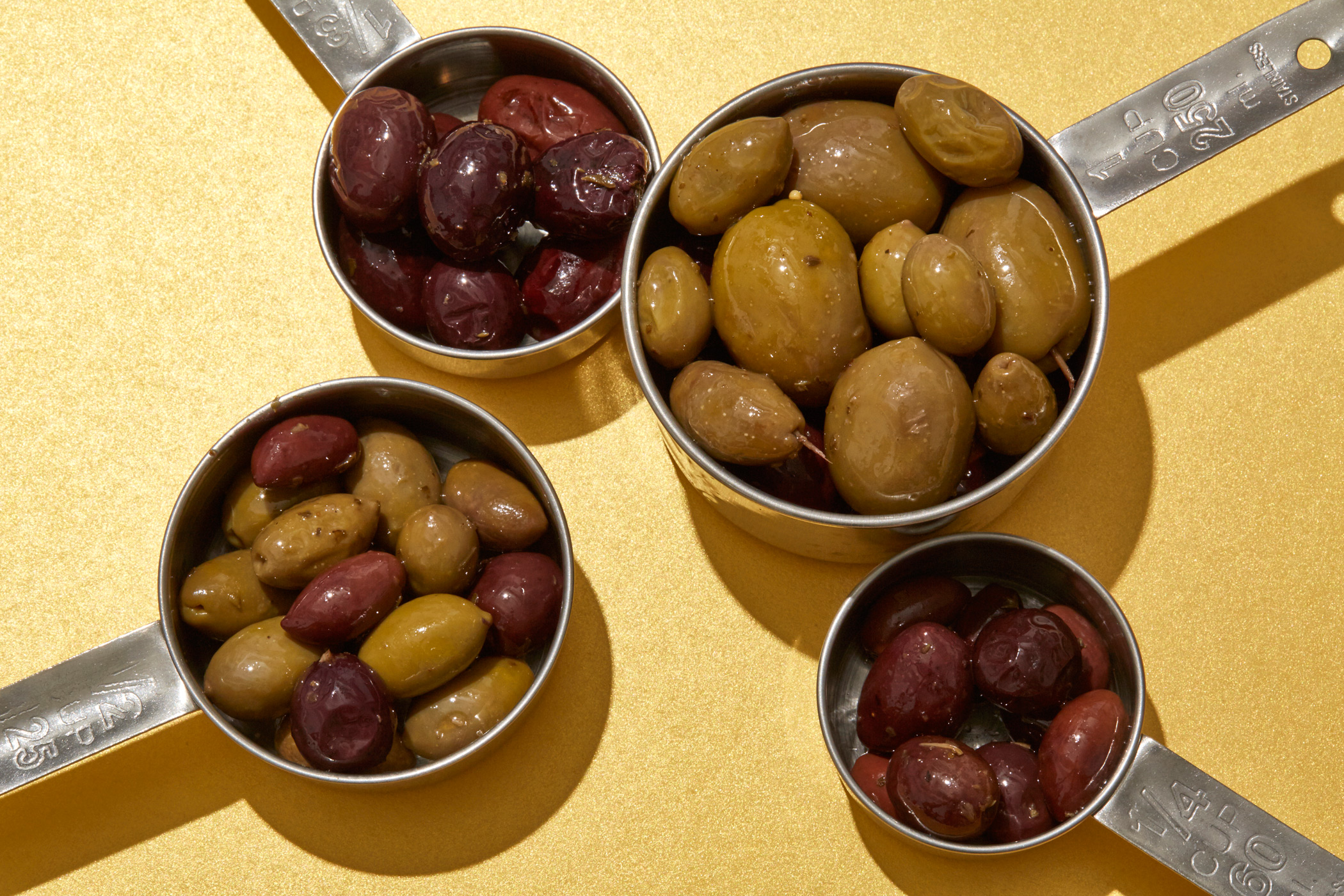
Why they’re good for you: We know olive oil is a common ingredient in a healthy diet, but don’t forget about its source. Olives are high in healthy fat that can benefit your heart and brain and keep weight in check. Research has also suggested that olives are a good source of antioxidants that prevent the buildup of bad cholesterol in artery walls. They’re also a fermented food, and therefore are good sources of gut-friendly bacteria.
How to eat it: Pour them into a dish and serve, or slice them up and add them to any pasta recipe.
Nutrition per 1 large olive: Calories: 5, Fat: 0.5 g, Cholesterol: 0 mg, Sodium: 32 mg, Carbohydrates: 0.3 g, Dietary fiber: 0.1 g, Sugars: 0 g, Protein: 0 g.
Asparagus
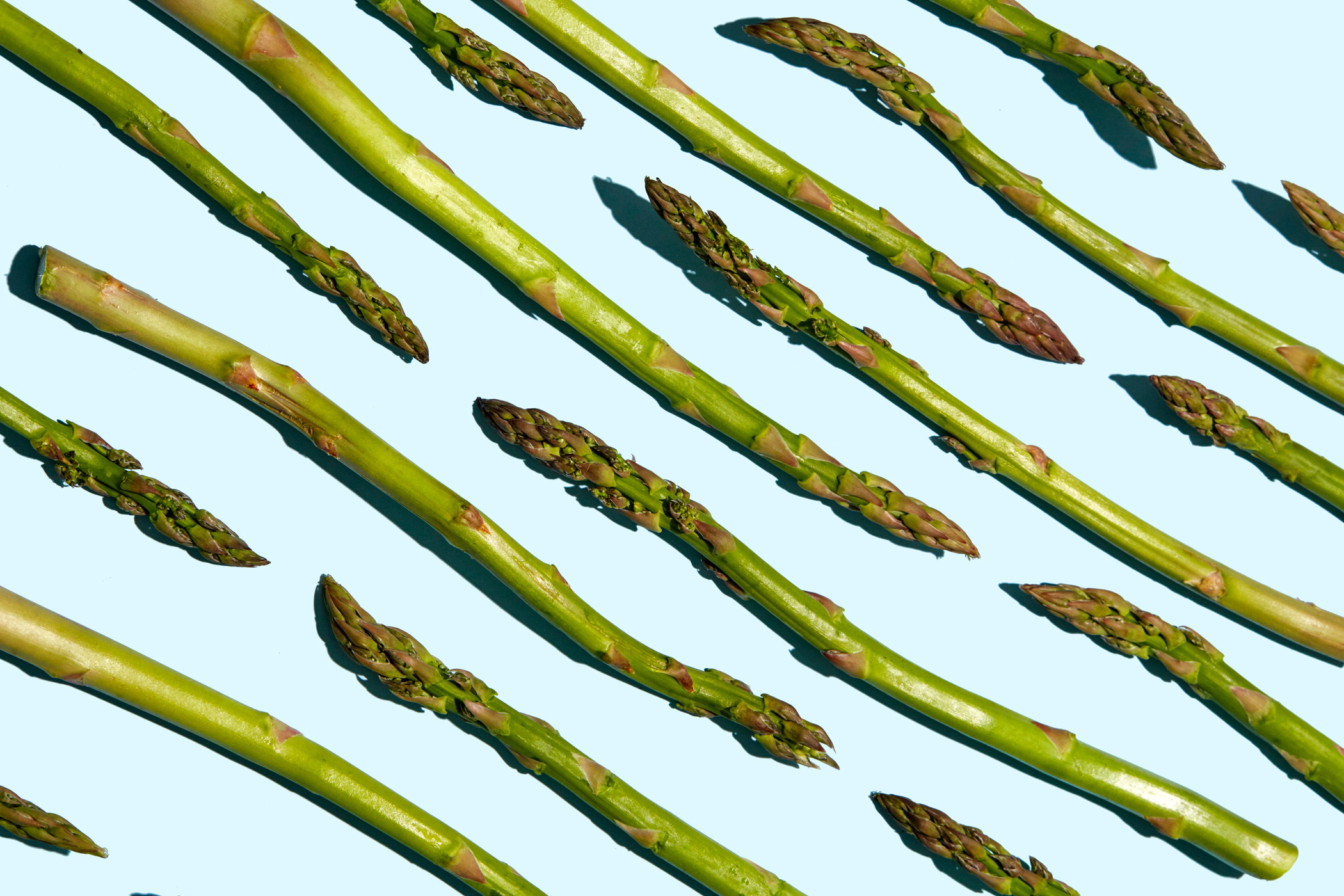
Why it’s good for you: Asparagus is a good source of folate, which is essential for a wide variety of body functions, as well as vitamins A, C and K. When purchasing asparagus, avoid spears with smashed tips, which will spoil more easily.
How to eat it: Use a peeler to cut asparagus into little ribbons to mix into salads. Also try them oven roasted whole at 375 °F for 12 minutes and then served with sunny side up eggs for breakfast. There’s something really fun about poking egg yolks with an asparagus spear.
Nutrition per 1 spear: Calories: 3, Fat: 0 g, Cholesterol: 0 mg, Sodium: 0 mg, Carbohydrates: 0.6 g, Dietary fiber: 0.3 g, Sugars: 0.3 g, Protein: 0.4 g.
Figs

Why they’re good for you: This fruit is high in both vitamins A and C, and have a unique taste that allows flexibility for both sweet and savory dishes. Avoid figs with bruises, but they should be a bit soft when you’re choosing which ones to bring home.
How to eat it: Pair them with healthy appetizers like almonds and cheese for your guests, or get cooking with these 20 Fantastic Fig Recipes.
Nutrition per 1 fig: Calories: 37, Fat: 0.2 g, Cholesterol: 0 mg, Sodium: 0 mg, Carbohydrates: 9.6 g, Dietary fiber: 1.4 g, Sugars: 8 g, Protein: 0.4 g.
Kohlrabi

Why it’s good for you: This peculiar-looking root vegetable has a pale green or purple bulb which sprout multiple stalks with dark leaves–and you can eat all its parts. Kohlrabi is a cousin to broccoli and cauliflower and is high in fiber and potassium.
How to eat it: They taste great roasted in olive oil or nestled under a roast chicken as it cooks. You can also try Honey-Glazed Kohlrabi with Onions and Herbs.
Nutrition per 1 cup: Calories: 36, Fat: 0.1 g, Cholesterol: 0 mg, Sodium: 27 mg, Carbohydrates: 8.4 g, Dietary fiber: 5 g, Sugars: 4 g, Protein: 2 g.
Pork Tenderloin
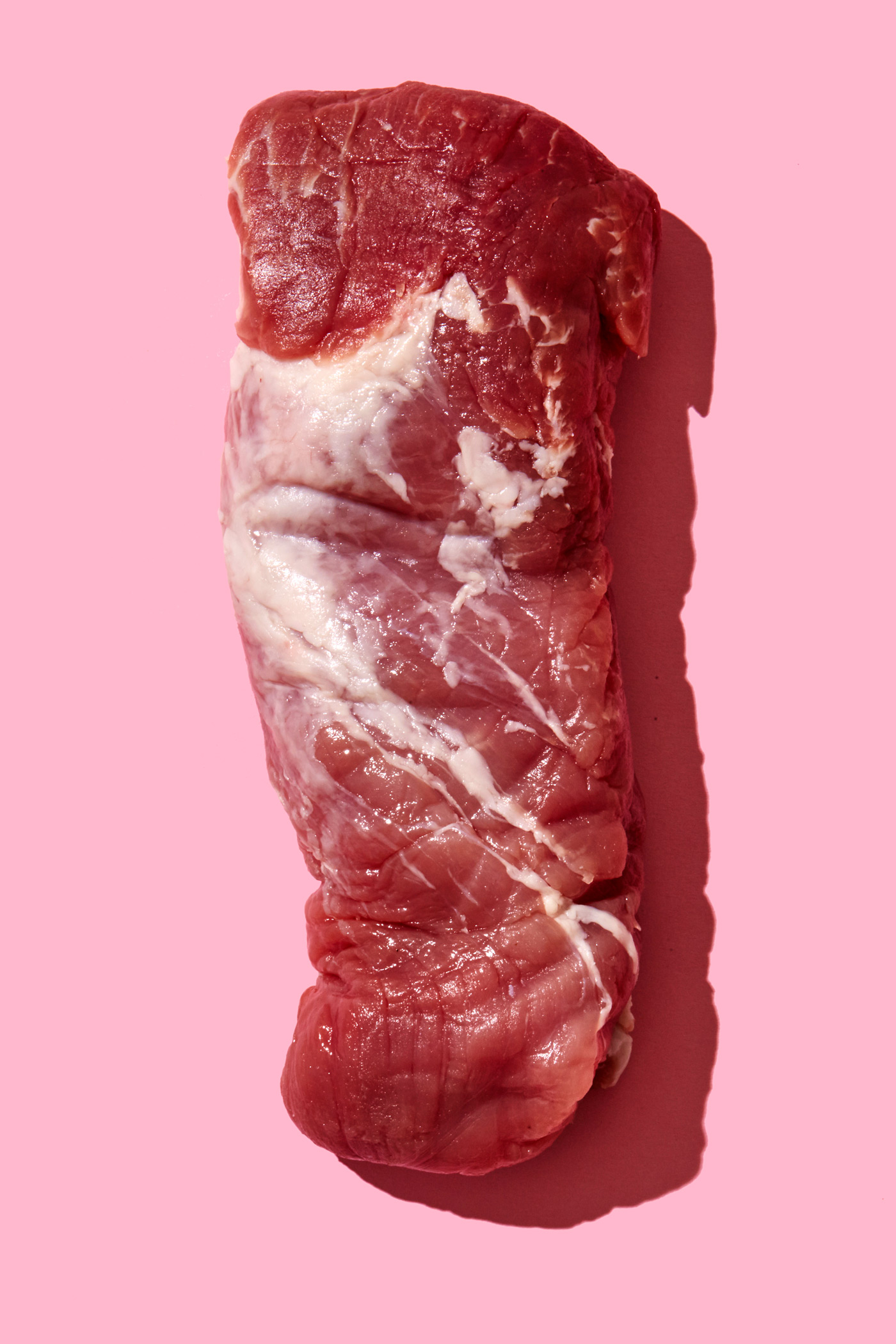
Why it’s good for you: Pork tenderloin is now certified with the American Heart Association “heart check” mark, indicating it qualifies as an extra-lean and heart healthy meat. Additionally, it is an excellent source of protein, B vitamins and zinc.
How to eat it: 18 Light Pork Loin Recipes
Nutrition per 3 ounces: Calories: 159, Fat: 5.4 g, Cholesterol: 80 mg, Sodium: 55 mg, Carbohydrates: 0 g, Dietary fiber: 0 g, Protein: 26 g.
Coffee

Why it’s good for you: There’s been back and forth on how much is too much when it comes to the morning cup-o-joe. But one study of 130,000 adults found no evidence that coffee increases the risk for health problems like heart disease or cancer, even among people who drank 48-ounces a day. The fact is, coffee is a complex drink containing hundreds of different compounds. Some of those include antioxidants that have been linked to a lower risk for type 2 diabetes, Alzheimer’s and liver cancer, Romano says. Keep in mind, that’s without added sugar and cream.
How to eat it: Brew yourself a cup in the morning and drink it as plain as possible—the health benefits come from the coffee, not the cream and sugar you add to it.
Nutrition per 1 cup: Calories: 5, Fat: 0 g, Cholesterol: 0 mg, Sodium: 2 mg, Carbohydrates: 0.6 g, Dietary fiber: 0 g, Sugars: 0 g, Protein: 0.7 g.
Kombucha

Why it’s good for you: This fermented drink is rich in probiotics, which benefit the healthy bacteria in your gut, aid in digestion, and increase the absorption of nutrients in food.
How to eat it: Kombucha is increasingly becoming an easy-to-find beverage at the grocery.
Nutrition per bottle: Calories: 33, Fat: 0 g, Cholesterol: 0 mg, Sodium: 10 mg, Carbohydrates: 7 g, Sugars: 2 g, Protein: 0 g.
Buckwheat

Why it’s good for you: This whole grain, which is also gluten-free, is rich in fiber and is a complete protein. (Fun fact: it’s what’s used to make soba noodles.)
How to eat it: It can be used as the base for a dish instead of rice, in soups or in tasty baked goods like Buckwheat Belgian Waffles.
Nutrition per 1 cup: Calories: 583, Fat: 5.8 g, Cholesterol: 0 mg, Sodium: 2 mg, Carbohydrates: 121.6 g, Dietary fiber: 17 g, Protein: 23 g.
Ginger Root

Why it’s good for you: This twisted root is a natural remedy for nausea and motion sickness and has been used in traditional medicine for thousands of years. Not only does it pack a zingy flavor, it also contains compounds like beta-carotene and capsaicin, which provide all sorts of healing and immune supportive wonders to the body.
How to eat it: If you’re worried about having to buy a whole root and only using a little bit, wrap it and store in the freezer. Take it out and microplane it onto fish, chicken, salad dressings, or anywhere you need a little zing.
Nutrition per 5 small slices: Calories: 9, Fat: 0.1 g, Cholesterol: 0 mg, Sodium: 1 mg, Carbohydrates: 2 g, Dietary fiber: 0.2 g, Sugars: 0.2 g, Protein: 0.2 g.
Tahini
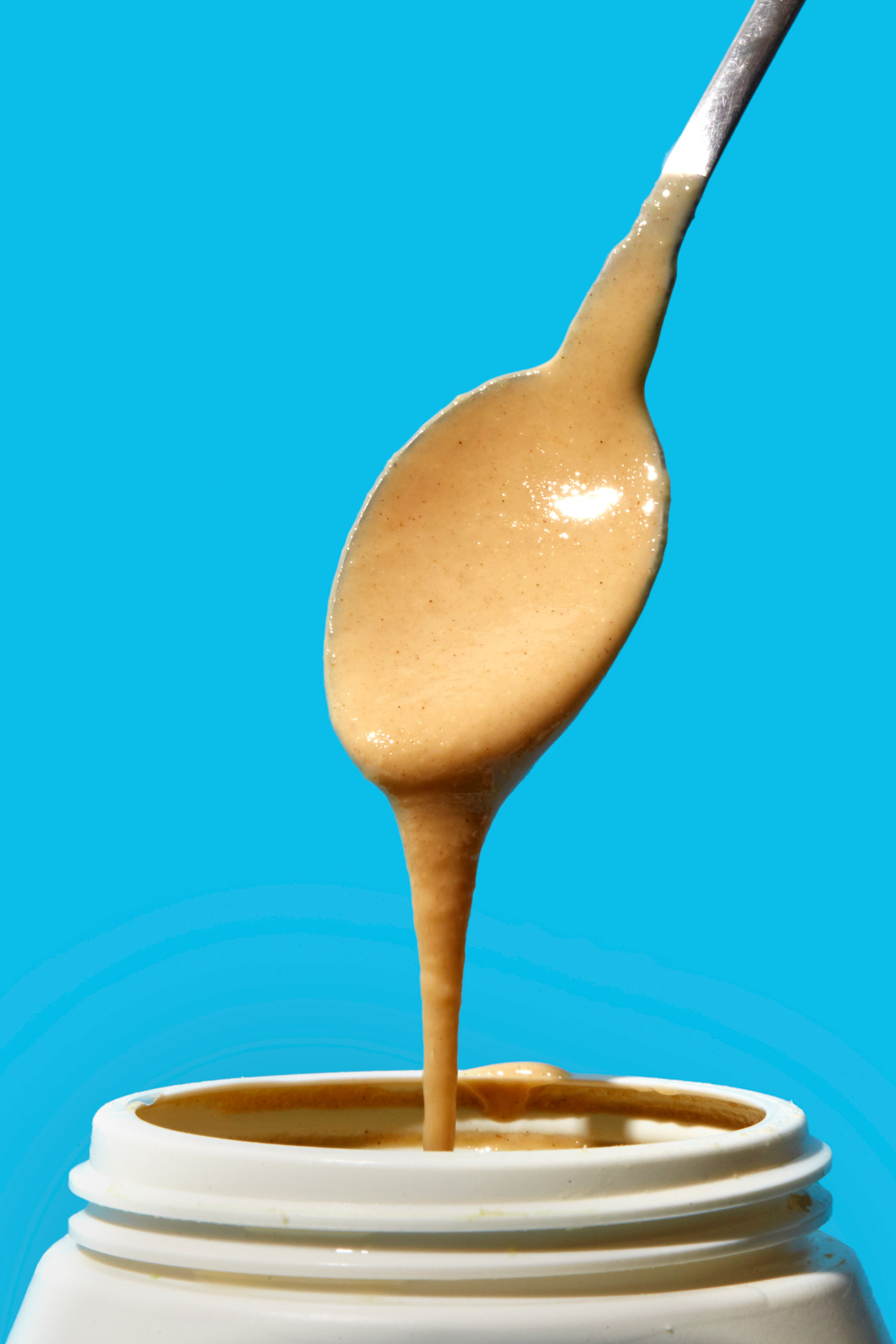
Why it’s good for you: Tahini, which is made from ground sesame seeds, is a good way get in some calcium, iron, potassium and vitamin E. Just one tablespoon has 110 mg of phosphorus, too, which is critical for the formation of bones and teeth. It also works with B vitamins to help with nerve signaling, normal heartbeat, and muscle contractions.
How to eat it: Tahini is a great base for salad dressings and marinades for fish. It’s also a key ingredient in hummus.
Nutrition per 1 tbsp: Calories: 89, Fat: 8 g, Cholesterol: 0 mg, Sodium: 17 mg, Carbohydrates: 3.2 g, Dietary fiber: 1.4 g, Sugars: 0.1 g, Protein: 3 g.
Basil

Why it’s good for you: Basil, which is actually a member of the mint family, is the star ingredient in pesto. The oil extracts from basil leaves contain antioxidant compounds that combat inflammation. Also high in vitamins, it’s a simple way to add a touch of nutrition to many recipes, and it pairs well with hearty vegetables.
How to eat it: You can’t go wrong tossing it into Asian stir fries, onto pasta or pizza, and shredding it into salad. Tear or cut just before serving, and check out Cooking Light’s Guide to Basil.
Nutrition per 5 leaves: Calories: 1, Fat: 0.02 g, Cholesterol: 0 mg, Sodium: 0 mg, Carbohydrates: 0.07 g, Dietary fiber: 0 g, Sugars: 0 g, Protein: 0.08 g.
Pistachios

Why they’re good for you: In addition to their heart-healthy fats, pistachios are rich in antioxidants, including lutein, beta-carotene and gamma-tocopherol. They are also high in vitamin A, which is important for vision and proper organ function. They’re delicious and surprisingly light for a nut: 50 kernels are only around 160 calories.
How to eat it: Keep pistachios in the fridge so you can regularly chop them up and toss them into salads, on top of roasted broccoli, and even into soups.
Nutrition per 1 ounce serving: Calories: 159, Fat: 13 g, Cholesterol: 0 mg, Sodium: 0 mg, Carbohydrates: 8 g, Dietary fiber: 3 g, Sugars: 2.2 g, Protein: 6 g.
Spelt
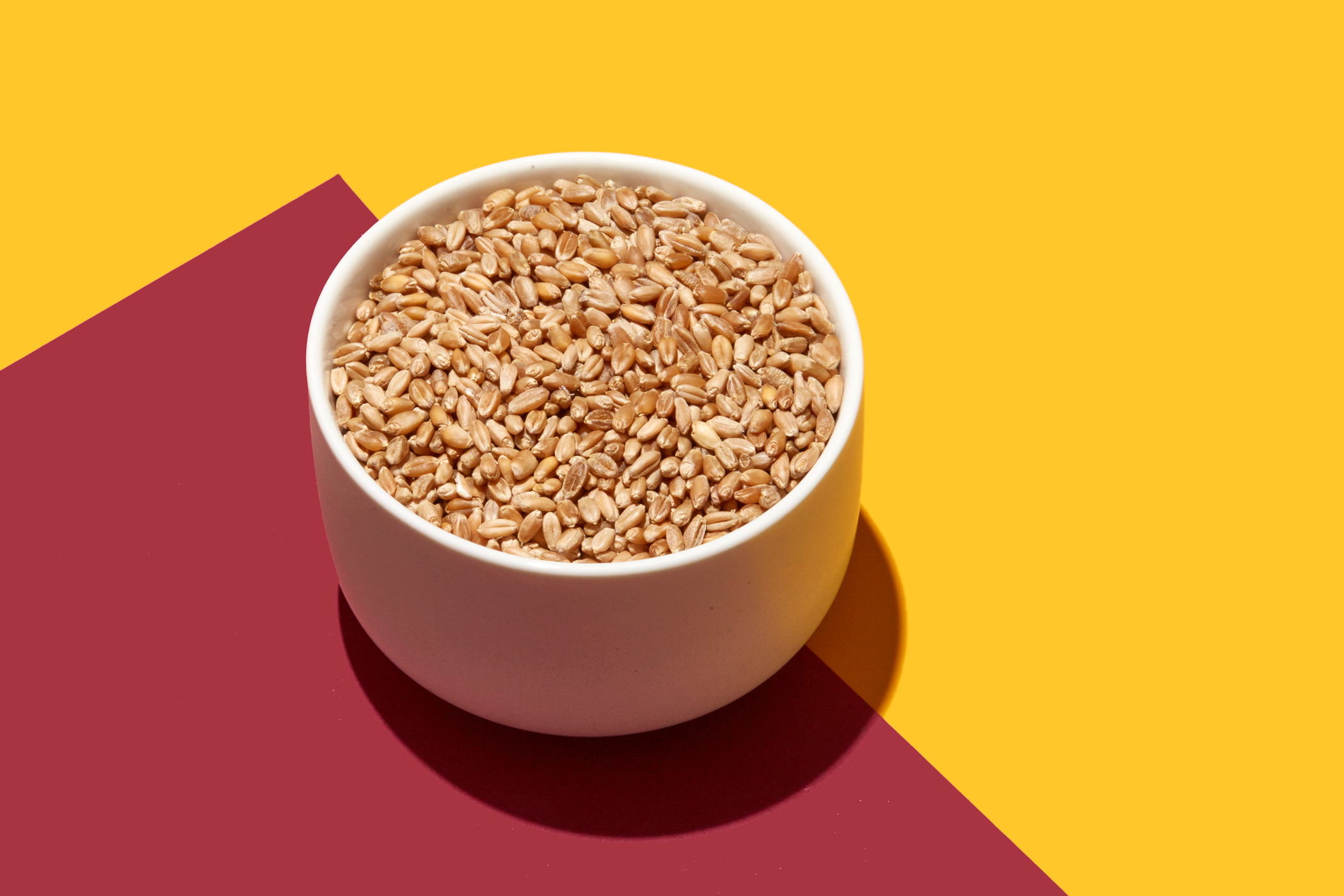
Why it’s good for you: Spelt is becoming an increasingly popular grain due to its nutritional profile. Spelt includes complex carbohydrates, and is rich in both soluble and insoluble fiber, vitamin B2, niacin, manganese, thiamin, copper and magnesium. It even has fatty and amino acids, which are important for body function.
How to eat it: Try this: Spelt-and-Wild Mushroom Soup with Pasta.
Nutrition per serving: (one cup,cooked) Calories: 246, Fat: 2 g, Cholesterol: 0 mg, Sodium: 10 mg, Carbohydrates: 51.3 g, Dietary fiber: 8 g, Protein: 11 g.
Sunflower Seeds

Why they’re good for you: Seeds, like sunflower seeds for example, are high in vitamin E which has antioxidant activity that’s good for immune function. One ounce of dry-roasted sunflower seeds contains 7.4 mg of vitamin E, which is 37% of your daily value.
How to eat them: Toss them on top of salads, in oatmeal, or pour a handful into a baggie and eat them as a snack.
Nutrition per 1 ounce: Calories: 165, Fat: 14 g, Cholesterol: 0 mg, Sodium: 1 mg, Carbohydrates: 7 g, Dietary fiber: 3 g, Sugars: 1 g, Protein: 5.5 g.
Parsley
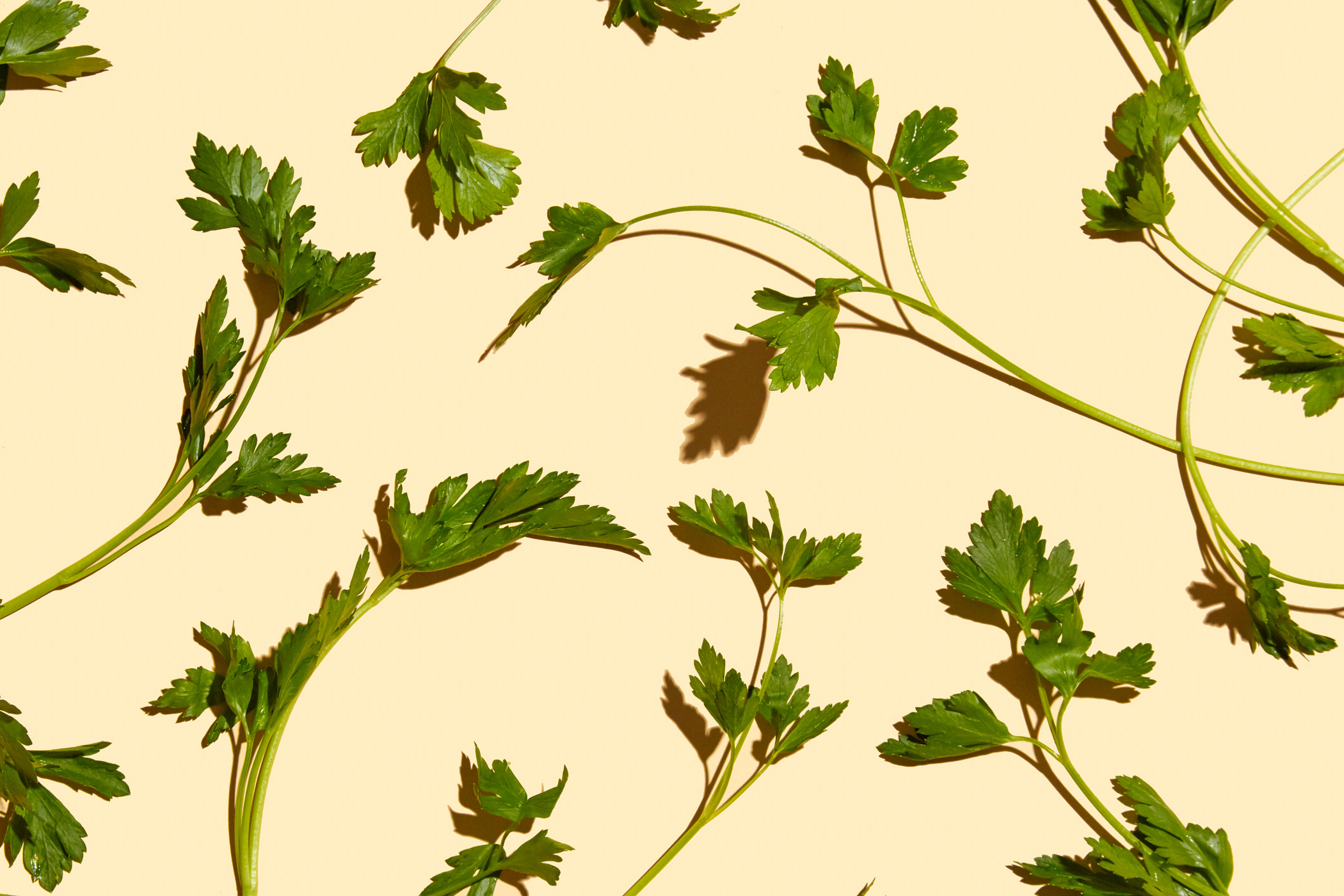
Why it’s good for you: Parsley is rich in many essential vitamins that play a role in bone, nervous system and immune health. This herb also contains flavonoids including apigenin, chrysoeriol, and luteolin—which is thought to have anti-inflammatory effects. Consider making parsley a kitchen staple if you haven’t already.
How to eat it: Buy a bunch on the weekend and use it on everything all week—it perks up pretty much any dish. Slice it super-thin and use it on top of pasta, mixed into salads, on top of a roast chicken breast, into a pesto puree or onto quinoa- or couscous-based salad.
Nutrition per 10 sprigs: Calories: 4, Fat: 0.08 g, Cholesterol: 0 mg, Sodium: 6 mg, Carbohydrates: 0.6 g, Dietary fiber: 0.3 g, Sugars: 0.08 g, Protein: 0.3 g.
Chili Flakes
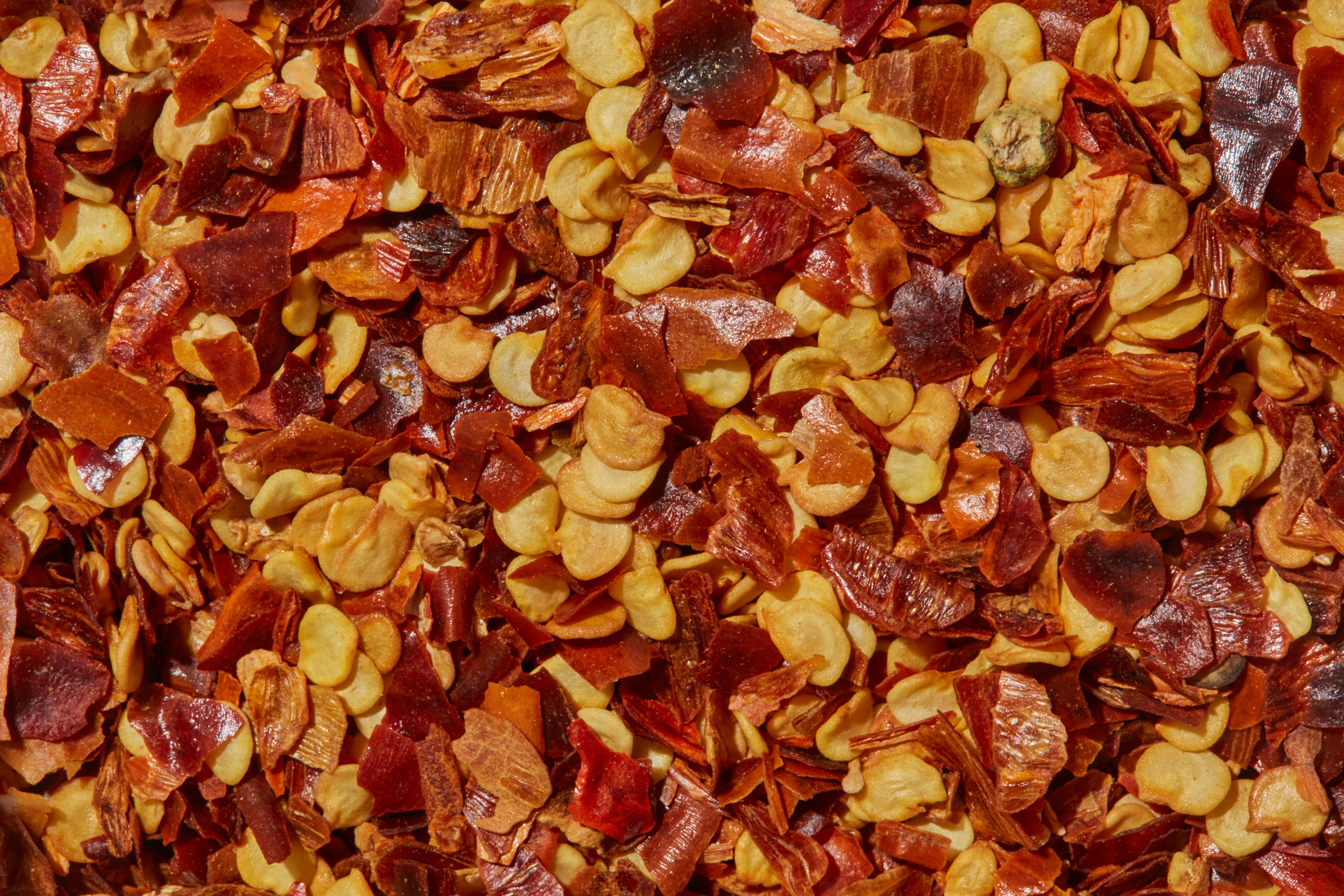
Why they’re good for you: If chili paste is a little too hot for your liking, try adding just a touch of chili flakes to a dish—it works for pretty much anything savory—for something a little more subtle, but still palate-changing. Not to mention some research has shown spicy food can increase satiety and calorie burn.
How to eat it: Sprinkle onto eggs, pizza, avocado toast, or into a salad dressing of olive oil, garlic, lemon juice and parmesan.
Nutrition per 1 tsp: Calories: 8, Fat: 0.4 g, Cholesterol: 0 mg, Sodium: 77 mg, Carbohydrates: 1.3 g, Dietary fiber: 1 g, Sugars: 0.2 g, Protein: 0.4 g.
Mint
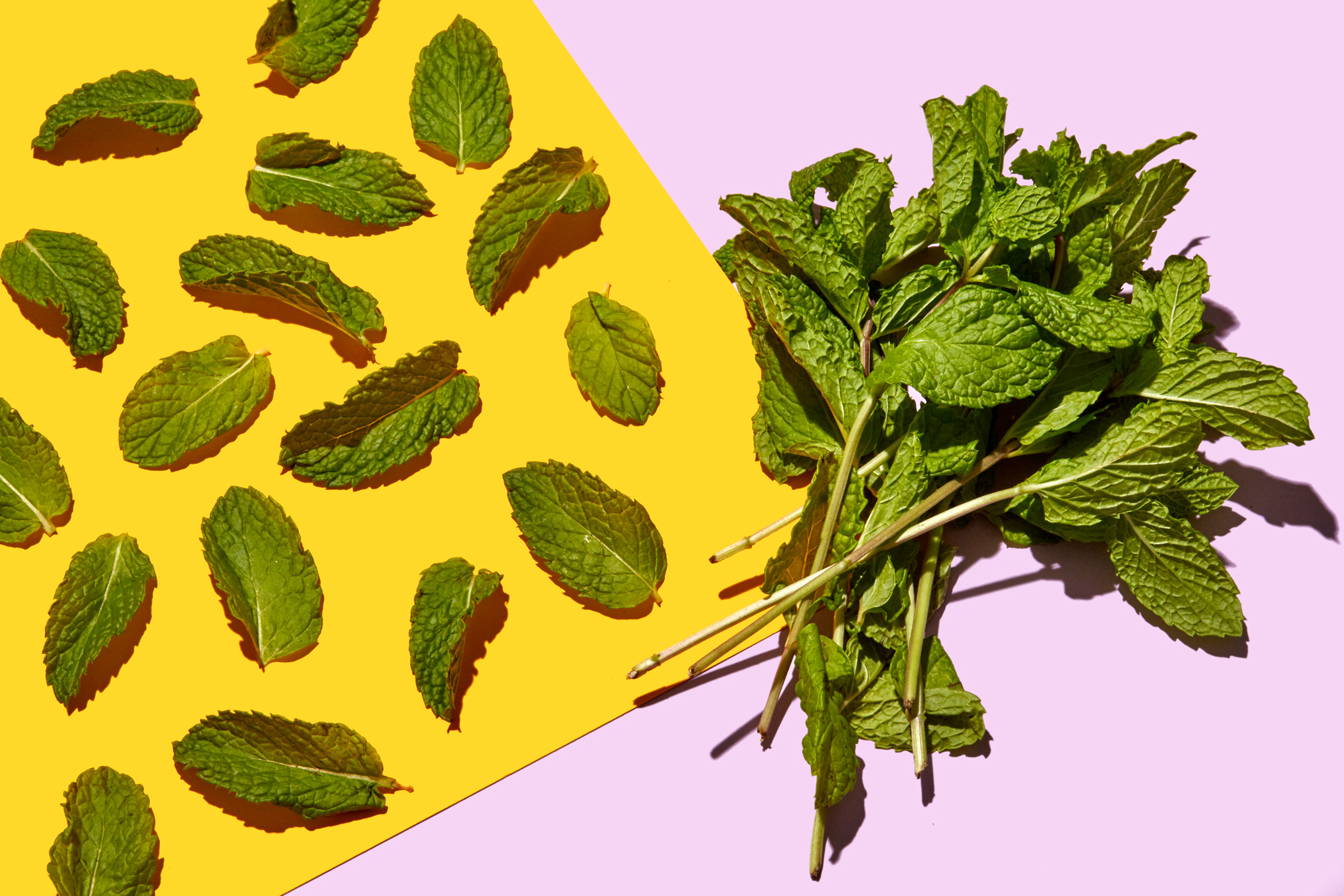
Why it’s good for you: The aromatic herb has compounds in its leaves that have been used for centuries to treat digestive issues. Mint is also thought to have antimicrobial effects and antiviral effects, and is a soothing herb with unique flavor for cooking and for drinks. There are many different kinds, from spearmint to apple mint.
How to eat it: Add some mint to a bowl of berries, or into a grain-based dish for a new flavor.
Nutrition per 5 leaves of mint: Calories: 0, Fat: 0.01 g, Cholesterol: 0 mg, Sodium: 0 mg, Carbohydrates: 0.06 g, Dietary fiber: 0.1 g, Protein: 0.02 g.
Carrots
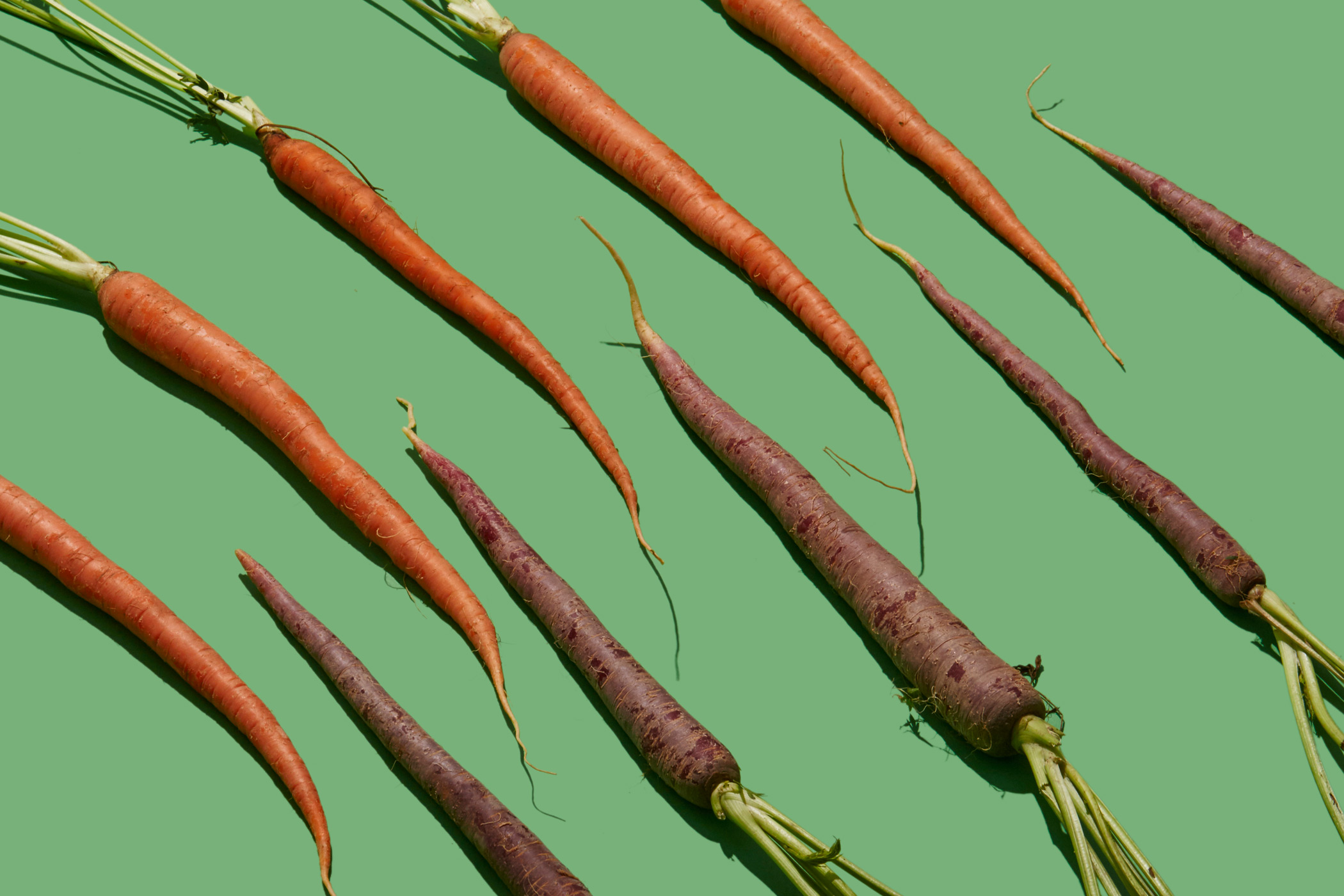
Why they’re good for you: Carrots have long been a go-to veggie, but did you know that they come in many different colors like reds, purples and yellow? Standard orange carrots contain vitamin A, which is essential for healthy sight. Colorful carrots also contain other healthy antioxidants like lycopene and beta-carotene pigment. Lycopene is the same pigment that gives tomatoes their bright red, and it’s linked to a lower risk of certain cancers.
How to Eat it: The simplest way to eat a carrot is to give it a wash and a good chomp.
Nutrition per carrot: Calories: 25, Fat: 0.2 g, Cholesterol: 0 mg, Sodium: 42 mg, Carbohydrates: 6 g, Dietary fiber: 2 g, Sugars: 3 g, Protein: 0.6 g.
Raw Peanut Butter

Why it’s good for you: Peanut butter is your friend, and you shouldn’t opt for a low-fat version. It’s high in filling fiber and protein, so just a little can go a long way when it comes to satisfying a sweet tooth.
How to eat it: Peanut butter is pretty self explanatory, but here are some techniques to try: Spread a tablespoon onto an apple or a large whole grain cracker and then dot it with sriracha hot sauce; put one to two tablespoons into an all-vegetable smoothie for added richness and fat; or swirl a small spoonful into your greek yogurt. (Why no one has invented peanut butter yogurt yet is beyond us.)
Nutrition per 2 tbsp: Calories: 191, Fat: 16 g, Cholesterol: 0 mg, Sodium: 5 mg, Carbohydrates: 7 g, Dietary fiber: 2 g, Sugars: 3.4 g, Protein: 7 g.
Amaranth

Why it’s good for you: Though it’s often referred to as a grain, amaranth is actually a seed that is rich in fiber and naturally gluten free, making it appropriate for people with celiac disease. In addition, it’s a complete protein and contains cholesterol lowering fiber.
How to eat it: It can be turned into a morning porridge, popped like popcorn and used in sweet treats, too, like this Vanilla Amaranth with Peach Compote.
Nutrition per 1 cup: Calories: 251, Fat: 4 g, Sodium: 15 mg, Carbohydrates: 46 g, Dietary fiber: 5 g, Protein: 9.4 g.
More Must-Reads from TIME
- Donald Trump Is TIME's 2024 Person of the Year
- Why We Chose Trump as Person of the Year
- Is Intermittent Fasting Good or Bad for You?
- The 100 Must-Read Books of 2024
- The 20 Best Christmas TV Episodes
- Column: If Optimism Feels Ridiculous Now, Try Hope
- The Future of Climate Action Is Trade Policy
- Merle Bombardieri Is Helping People Make the Baby Decision
Contact us at letters@time.com